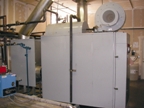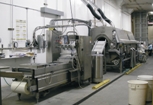
What could be better? A vegetarian products manufacturer identifies a real need in his marketplace. He develops a tasty product to fill it, then he has to expand his processing capacity rapidly to meet demand. But, even with four boilers, he can't run all his steam houses simultaneously. This entrepreneur's story follows a uniquely natural course to a healthy success.
From Naturalist to Entrepreneur
Turtle Island Foods, Inc. of Hood River, OR (one hour east of Portland) was founded in 1980 by Seth Tibbott-the current president and CEO. Starting Turtle Island Foods as a storefront operation in Forest Grove, OR, Tibbott was making a traditional Indonesian cultured soy product called Tempeh-which was the backbone of the company for over two decades. Steady growth pushed Turtle Island out of its original storefront and into a commercial kitchen in an abandoned schoolhouse in Husum, WA (75 miles east of Portland) before the company finally settled into its Hood River plant in 1992.How did Seth Tibbott, vegetarian naturalist and environmental activist, become the second largest Tempeh manufacturer in the US and the inventor of Tofurky? He came across the concept of Tempeh in a magazine that included an address you could write to for a free spore sample. Tempeh is a boiled soybean product to which the beneficial mold called rhizopus oligosporus has been added. When cultured at the proper temperature, this mixture of soybeans and mold grows into a solid cake. Tibbott made his first batch in a jury-rigged incubator. He liked it so much he shared it with his friends who were soon asking him to make it for them. For Tibbott, a light bulb literally when on. He was incubating the Tempeh in a little refrigerator heated by a string of Christmas tree lights. He felt that there was a future in America for this product and decided to quit his day job as a teacher-naturalist and began working nights to finance his new Tempeh venture.
In the early stages of the company, the main customers were small co-ops and natural foods stores that Tibbott delivered to directly in his car. Through the years, the product line broadened, and the natural foods industry grew at a phenomenal rate. With an average growth rate of over 40% the past 3 years, Turtle Island Foods products are now sold in such stores as Whole Foods, Wild Oats, Publix, Safeway and Trader Joes.
"
Situated on the Columbia River with Mt. Hood as its backdrop, nothing could look more peaceful than the setting for Turtle Island Foods. So it is ironic that familial conflict should be the impetus for its greatest success.
Turtle Island's sudden growth basically hinged on the development in 1995 of a product called Tofurky. Thanksgiving and Christmas festive meals can be trying times for vegetarians and their families. Agreeing on an appropriate, easy-to-fix food to serve the vegetarian family members produced unwanted feelings of "
Meat Processing Without the Meat
According to Jaime Athos, Turtle Island Foods' Operations Manager, "We use the same processing equipment that a meat processing plant would use. Basically, the Tofurky roast is a very-large-diameter, but short in length, sausage. So, when we saw a need to add new products, we looked to the meat industry, again. We asked, how does the turkey industry fill in the lean times outside the holiday period? What do they do to keep themselves in business and keep rolling product out the door? What they do is make deli sliced products. So we followed their lead. The sausage is cooked in a casing and then we peel it and slice into ultra thin slices. We vacuum package it after that in a couple of packaging lines. To produce the Jurky, we take a long length of sausage and cut it into little coins-medallion shapes. We marinate it, then we put it into our smoker, which dries it during the course of the smoking."
Starving for Steam
From the outset, Turtle Island was using steam jacketed kettles to produce their Tempeh. So steam has always been an integral part of their process. Athos recalls how Turtle Island's steam production increased with its growth, "With the move to Hood River, Seth purchased a new boiler. It was a 9.5-hp bent tube atmospheric boiler. As the sales volume ramped up, he added another a 9.5-hp bent tube boiler. A little later, he added a 25-hp bent tube and ultimately a 50-hp in addition to that."We were starving for steam. The Tofurky is all cooked in steam ovens or houses. And we were finding that though we have four steam houses in our plant, we were actually limited to running only two of those at the same time. Our existing boiler capacity just could not keep up with the steam demands.
"Plus, we have a clean-in-place (CIP) system that requires quite a bit of steam power because you're heating up a large volume of water with sanitizing solution in it and circulating that throughout long pipes that run throughout the plant. It definitely puts a demand on our steam system.
"As is probably true of a lot of food manufacturing facilities, the steam demand fluctuates up and down throughout the day. I think that is where our boilers were letting us down. The ability to ramp up quickly to meet that kind of demand just wasn't there."
Weighing the Alternatives
Turtle Island Foods had two options: Add another boiler to increase capacity beyond 95 hp or replace all the boilers with a different kind of steam-producing technology that would basically have the same capacity. Jaime Athos describes the approach taken to solve the steam problem. Adding more capacity with the existing technology meant adding another bent tube atmospheric style boiler. The ones that we had in the past ran very well, and we had a pretty good history with them. But, what we found was that it seemed that we had all the capacity in terms of the horsepower that we needed. But bent tube atmospheric boilers just weren't able to respond to the kind of up and down demand that we were subjecting them to."
Good Stewards of the Environment
The effect of the boiler on the environment was another factor. As Athos puts it, "Concern for the environment is sort of who we are as a company."The Solution
Athos continues, "There were several features we were comparing amongst the boilers we investigated. One was the recovery time. That was pretty critical for us because of the up and down nature of the demands on our system. Another one was energy efficiency. As a growing company, it is easy to just add more and more capacity in an inefficient way. But in terms of our goals, it makes a lot of sense to think long-term. You pay a little bit more up front and recover that additional initial investment over the long term. The environmental affects were another major consideration."
Increased Efficiency, Increased Savings
The biggest benefit has been to the bottom line. Athos has seen a sizable drop in Turtle Island's energy usage, "I believe that the system efficiency of the bent tube atmospheric boilers that we were looking at was something on the order of 75 or maybe 80 percent only at the top of its range. I believe that this Miura boiler we have now is at least 10 to 15% better than that, consistently. That's substantial. As natural gas prices increase, we are even more pleased with the decision that we made. The return on our investment won't be long in coming."Big Fuel Savings"
From November 2004 to November 2005, Turtle Island Foods cooked 45.6% more product. In that period, the price of natural gas went up 25%. To their great relief, due to the in-service efficiency of the new boiler, the increase in their gas usage was only 12.2%. So, they increased their productivity per therm by 29.8% and decreased their natural gas usage on a per-pound-of-product basis by 22.9%!
Athos adds, "I would say that the Miura is recovering steam pressure within less than a minute of a major demand being placed on our steam system. It's able to actually increase the pressure of the steam lines when you turn on a steam house. Whereas with our older system, you're talking about 15 to 20 minutes of low steam pressure while the boilers struggled to catch up to demand. It really had a profound affect on the consistency of our product. Obviously if demand is rising and falling and the steam pressure is rising and falling, it makes it difficult to get really consistent cooking of your product. All kinds of quality problems result from that."
On the Horizon
Turtle Island Foods is about to expand into the remainder of their building which will bring them up to just under 30,000 sq. ft. Then they'll be adding more new equipment, confident that the Muira boiler will still be able to keep up with their growing demand.
Contact Miura Boiler, Inc. by mail at 600 Northgate Pkwy, Suite M, Wheeling, IL 60090-3201; phone at (847) 465-0001; fax at (847) 465-0011; e-mail at chicago@miuraboiler.com; or online at Web: www.miuraboiler.com.